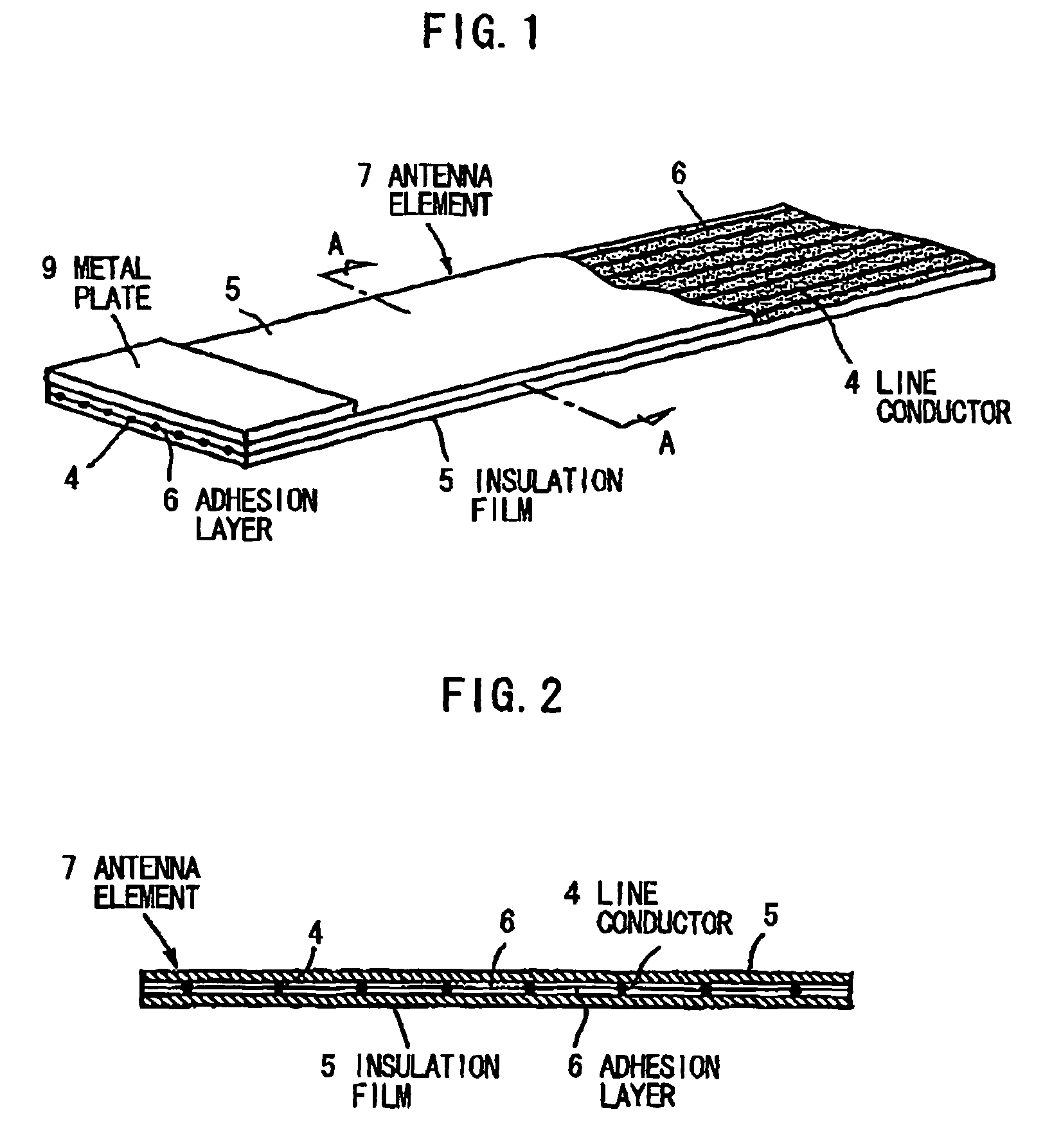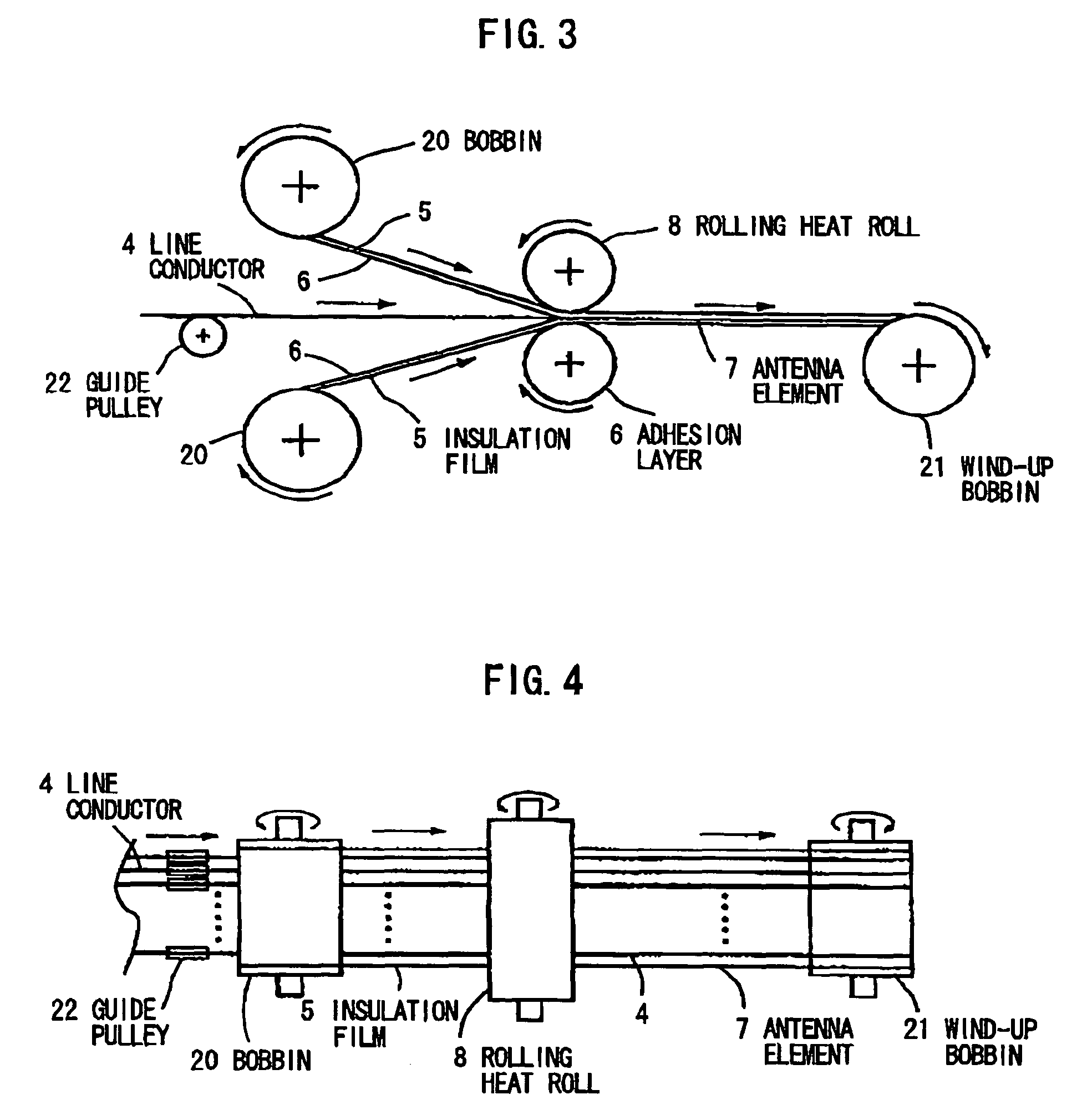Antenna and method of making the same
a technology of antenna and antenna body, applied in the direction of antenna, antenna details, protective material radiating elements, etc., can solve the problems of inability to match the impedance with the feeding portion, resistance increase, and inability to reduce the visibility, etc., and achieve the effect of free-form antenna
- Summary
- Abstract
- Description
- Claims
- Application Information
AI Technical Summary
Benefits of technology
Problems solved by technology
Method used
Image
Examples
example 1
[0076]As shown in FIG. 5, 50 lusterless silver coating copper alloy conductors 10 with a diameter of φ0.02 mm are in parallel arranged at equal intervals of 0.2 mm. Then, the antenna element 7 is formed by conducting the rolling adhesion that the conductors 10 are sandwiched by the transparent insulation films 5 (made of, e.g., polyethylene terephthalate or polycarbonate) with a thickness of 0.015 mm and with the adhesion layer 6 with a thickness of 0.01 mm by using the rolling heat rolls 8 at temperature of 150° C. in accordance with the method explained in FIGS. 3 and 4.
[0077]The antenna element is cut into two strips in equal length, being bent by 90 degrees in midway and forming the dipole antenna 12 to be 300 mm in length L. Then, the dipole antenna 12 is sandwiched by transparent insulating substrates 11 (made of, e.g., polyethylene terephthalate or polycarbonate) with a thickness of 0.015 mm and with an adhesion layer of 0.01 mm while placing a part to be the feeding portion ...
example 2
[0079]As shown in FIG. 6, 50 lusterless silver coating copper alloy conductors 10 with a diameter of φ0.02 mm are in parallel arranged at equal intervals of 0.2 mm. Then, the antenna element 7 is formed by conducting the rolling adhesion that the conductors 10 are sandwiched by the transparent insulation films 5 (made of, e.g., polyethylene terephthalate or polycarbonate) with a thickness of 0.015 mm and with the adhesion layer 6 with a thickness of 0.01 mm by using the rolling heat rolls 8 at temperature of 150° C. in accordance with the method explained in FIGS. 3 and 4.
[0080]The antenna element is cut into a strip with an appropriate length, being bent by 90 degrees in midway to form the rectangular loop antenna 13 to be 300 mm in long side and 50 mm in short side. Then, the loop antenna 13 is sandwiched by transparent insulating substrates 11 (made of, e.g., polyethylene terephthalate or polycarbonate) with a thickness of 0.015 mm and with an adhesion layer of 0.01 mm while plac...
example 3
[0082]As shown in FIG. 7, 50 lusterless silver coating copper alloy conductors 10 with a diameter of φ0.02 mm are in parallel arranged at equal intervals of 0.2 mm. Then, the antenna element 7 is formed by conducting the rolling adhesion that the conductors 10 are sandwiched by the transparent insulation films 5 (made of, e.g., polyethylene terephthalate or polycarbonate) with a thickness of 0.015 mm and with the adhesion layer 6 with a thickness of 0.01 mm by using the rolling heat rolls 8 at temperature of 150° C. in accordance with the method explained in FIGS. 3 and 4.
[0083]The antenna element is cut into a strip with an appropriate length, being bent in midway to form the inverted-triangular loop antenna 14 to be 300 mm in one side. Then, the loop antenna 14 is sandwiched by transparent insulating substrates 11 (made of, e.g., polyethylene terephthalate or polycarbonate) with a thickness of 0.015 mm and with an adhesion layer of 0.01 mm while placing a part to be the feeding po...
PUM
 Login to View More
Login to View More Abstract
Description
Claims
Application Information
 Login to View More
Login to View More - R&D
- Intellectual Property
- Life Sciences
- Materials
- Tech Scout
- Unparalleled Data Quality
- Higher Quality Content
- 60% Fewer Hallucinations
Browse by: Latest US Patents, China's latest patents, Technical Efficacy Thesaurus, Application Domain, Technology Topic, Popular Technical Reports.
© 2025 PatSnap. All rights reserved.Legal|Privacy policy|Modern Slavery Act Transparency Statement|Sitemap|About US| Contact US: help@patsnap.com



